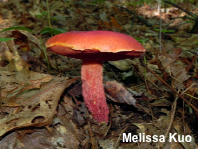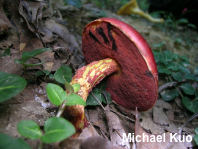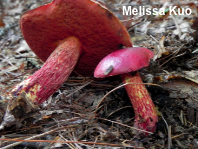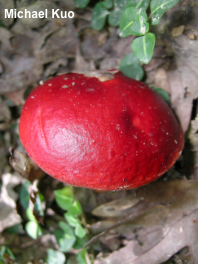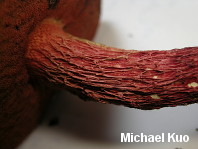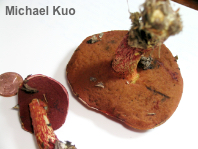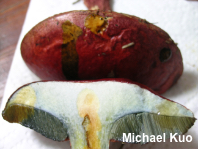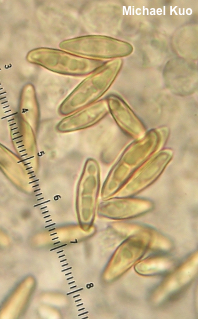| Major Groups > Boletes > Red-Pored Boletes > Butyriboletus frostii |

|
Butyriboletus frostii [ Basidiomycota > Boletales > Boletaceae > Butyriboletus . . . ] by Michael Kuo The sticky red cap of this fairly unmistakable bolete is red—like, the primary color red, rather than the "red" of so many bolete species that are actually brownish red or rusty red (and so on). Other distinguishing features for Butyriboletus frostii include its red pore surface; its deeply and coarsely reticulate stem; and the fact that its pore surface and flesh bruise promptly blue. Butyriboletus frostii is a mycorrhizal associate with hardwoods—especially oaks—in eastern North America, pockets of the Southwest, Mexico, and Central America. In the southeastern states, Butyriboletus floridanus is a similar species, also associated with oaks. Its cap is not quite as red, and its stem is less prominently reticulate. Boletus frostii and Exsudoporus frostii are former names. Description: Ecology: Mycorrhizal with oaks and other hardwoods; growing alone, scattered, or gregariously; summer and fall; widely distributed in eastern North America, Texas, pockets of the Southwest, Mexico, and Central America. The illustrated and described collections are from Kentucky. Cap: 3.5–8 cm; convex, becoming broadly convex; sticky when fresh; bald; bright red; the margin often pale yellow and overhanging slightly. Pore Surface: Dark red, becoming dirty brownish red; sometimes becoming faintly yellowish near stem and cap margin; bruising blue promptly; 2–3 circular pores per mm at maturity; tubes to 1 cm deep, olive at maturity. Stem: 4–8 cm long; 1–1.5 cm thick; equal; prominently, coarsely reticulate overall with a red reticulum; yellow underneath the red; basal mycelium whitish. Flesh: Whitish to pale yellow overall; red in stem base; pale blue when sliced. Odor and Taste: Not distinctive. Chemical Reactions: Ammonia negative to gray on cap surface; erasing blue to grayish or yellowish, then dull orange on flesh. KOH flashing gray to black, then resolving to orange on cap surface; orange on flesh. Iron salts negative to gray on cap surface; negative on flesh. Spore Print: Olive brown. Microscopic Features: Spores 13–22 x 4–5 µm; fusoid; smooth; yellow in KOH. Hymenial cystidia to about 40 x 10 µm; fusiform or lageniform; smooth; thin-walled; hyaline in KOH. Pileipellis an ixocutis; elements 2–5 µm wide, smooth, hyaline in KOH; subcutis elements 5–13 µm wide, yellowish to yellow in KOH. REFERENCES: (J. L. Russell, 1874) G. Wu, K. Zhao & Z. L. Yang, 2016. (Murrill, 1914; Coker & Beers, 1943; Singer, 1947; Snell & Dick, 1970; Smith & Thiers, 1971; Smith, Smith & Weber, 1981; Halling, 1983; Weber & Smith, 1985; Arora, 1986; Phillips, 1991/2005; Lincoff, 1992; Metzler & Metzler, 1992; Both, 1993; Bessette, Roody & Bessette, 2002; Roody, 2003; Miller & Miller, 2006; Binion et al., 2008; Kuo & Methven, 2014; Bessette, Roody & Bessette, 2016; Wu et al., 2016; Woehrel & Light, 2017; Baroni, 2017; Elliott & Stephenson, 2018; Sturgeon, 2018.) Herb. Kuo 08160601, 08111208. This site contains no information about the edibility or toxicity of mushrooms. |
© MushroomExpert.Com |
|
Cite this page as: Kuo, M. (2020, July). Butyriboletus frostii. Retrieved from the MushroomExpert.Com Web site: http://www.mushroomexpert.com/butyriboletus_frostii.html |
